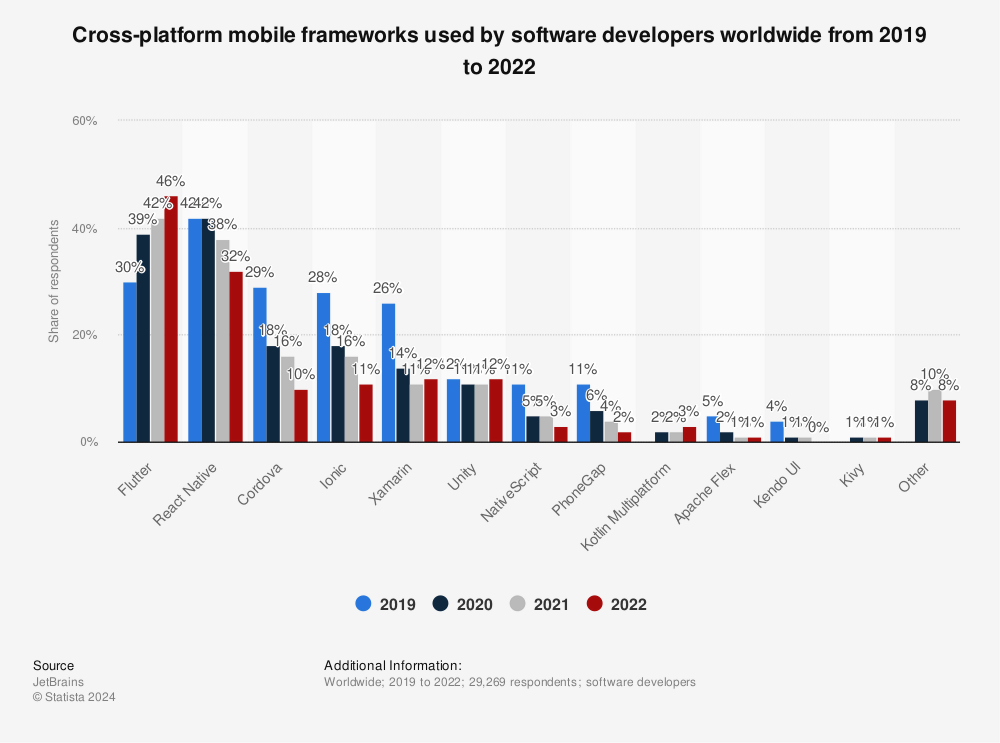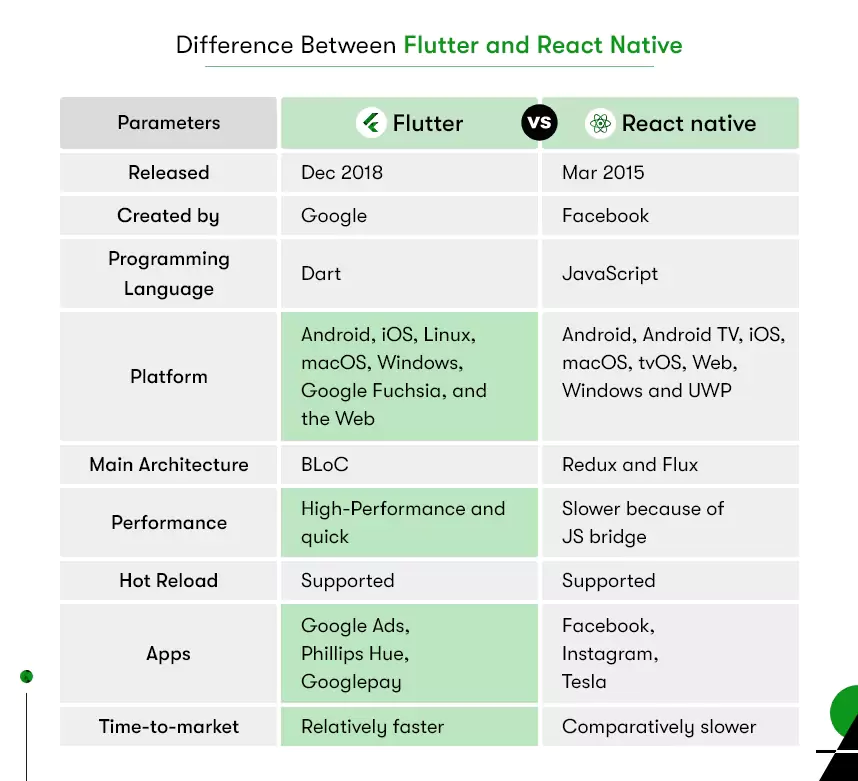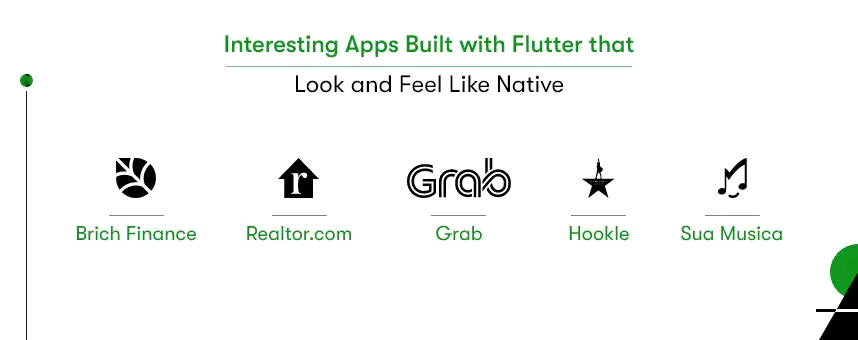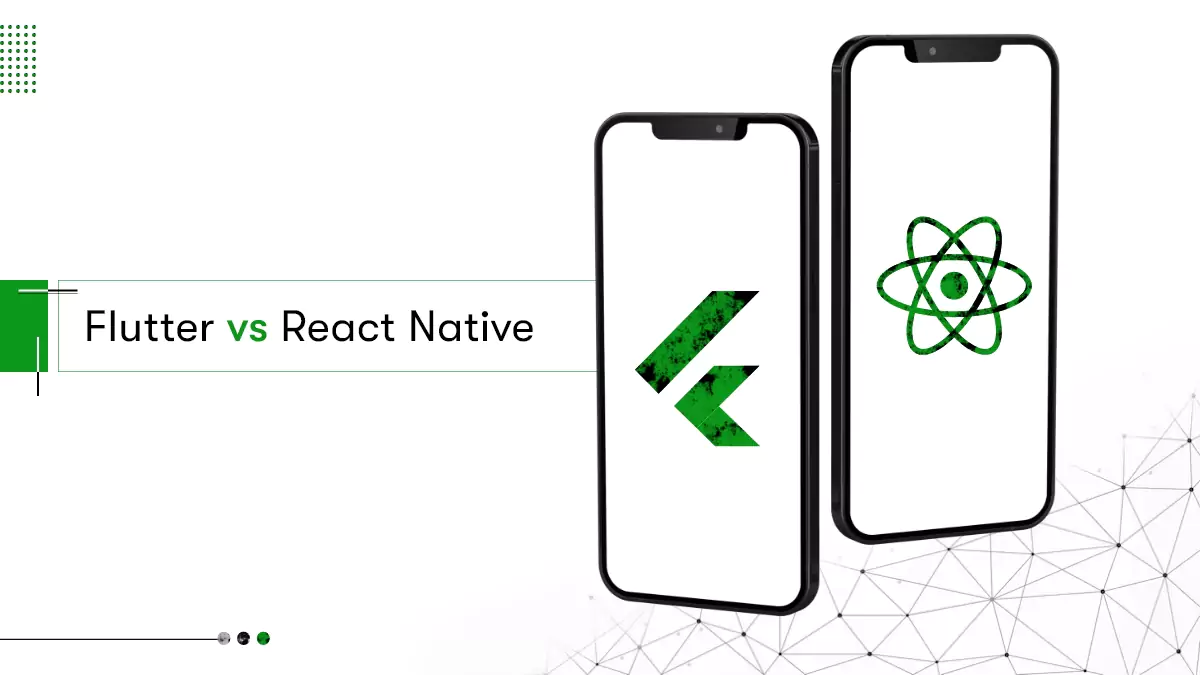Will the Flutter vs React Native war ever end?🙄 Will you ever be able to decide which cross-platform framework to use in 2024?😫 Well, to put an end to this confusion, here we are with the ultimate Flutter vs React Native comparison.
Have you ever seen a person enjoying the app even though the app takes a lot of time to load? I bet you would never have. Because nobody likes to use an app that overheats their devices, causes lag, or malfunctions. Right? That is why companies and brands go with native app development.
But as you know, Android is a mix of Java and C and C++. On the other hand, the iOS operating system is built on top of Swift and Objective-C. Hence, building native apps requires resources for both platforms’ programming languages, i.e., Swift and Java. As it seems, you literally have to develop and maintain two separate apps.
Then exists cross-platform technology that cuts off such dependency on developing apps separately for different platforms. We are discussing React Native vs. Flutter and not Flutter vs Native Script or Xamarin, or other technology. Because Flutter and React Native are the only ones that have made it to top cross-platform app development frameworks.
“Flutter is the most popular cross-platform technology as it is used by 42% of software developers using cross-platform frameworks in the world followed by React Native.” — Statista.

You will find thousands of mobile applications built using these frameworks, but which overrule the other one in Flutter Vs React Native comparison is always a debatable question.
Since this blog is written and reviewed by our expert team of Flutter and React Native developers, you don’t have to worry now. We have used their hands-on experience to describe the differences in detail. So let’s begin the discussion.
To start with, Why cross-platform app development?
Well, the whole world is moving towards digitization, and there is not a single purpose that can not be fulfilled using an application. 66% of the global population (almost 5.35 billion) uses the internet and spends an average of 6 hours and 58 minutes browsing the internet.
It’s no longer a luxury but a necessity for businesses to release applications and meet their customers’ expectations in real time. The cross-platform app development solution appears as a boon, saving money and drastically reducing the time to market. It allows you to handle the storm of rising application demand. On top of everything, it gives your application a look and feels like a native.
What was the need for cross-platform app development frameworks?
Happy users – Given the current tech-savvy era, people tend to have multiple devices (laptop, smartphone, computer, tablet, etc.), and certainly not all devices have the same operating system. Since cross-platform technologies let you build the app for multiple platforms from a single codebase, there will be no hassle to manage similar UI/UX or functionality on different devices.
Expansion – When a company uses a cross-platform framework like Flutter and React Native, it becomes easy to extend its market. For example, they have an Android app built with Flutter; now, they can easily use the same code and quickly penetrate the iOS market, too.
Reduce Upfront Expenses – Apps, specifically startup ones, won’t yield any penny until you release them. The cross-platform approach allows you to build and release the initial app version faster and see how the market perceives it, reducing upfront expenses.
Write once – Cross-platform technologies are built differently to save developers from writing code over and over again for different platforms. As a result, you create multiple apps in a single app development time.
Maintenance – The cross-platform app development invention is a gem if you don’t want the hassle of maintaining multiple apps. You make changes in the source code, and it will reflect on every platform as apps are built using the same codebase.
Now, there are many cross-platform app development frameworks available. But there is a cut-throat competition between Flutter and React Native.
What is Flutter?
Flutter is an open-source, cross-platform mobile app framework powered by Google. It allows you to build natively compiled apps for mobile, desktops, and web and up to six platforms using a single codebase. Flutter is relatively new, being launched in the year 2017; however, it has grabbed 148K stars on GitHub as we are writing this.
It has very strong community support, and some trusted names like Alibaba, Hamilton Broadway, Google Ads, and eBay are already on its list. It uses Dart as a programming language, which is a client-optimized programming language.

Advantages of using Flutter as your cross-platform app development framework
- Higher speed-to-market – Flutter’s built-in features, such as hot reload, enable fast development and deployment, compiling the code ahead of time and showing an app preview even before you rebuild it after minor code changes.
- Widgets – In addition to hot reload, Flutter’s widget-based UI design accelerates the development to a significant extent. Readily available and customizable third-party widgets in Dart Pub also integrate with Flutter easily.
- Mighty Ecosystem – The leverage of support from Google and ready-to-use SDKs of Google’s other products, such as Firebase.
- Feature-rich UI – Thanks to Flutter’s layered architecture, it produces meticulous components without affecting the rendering speed. Besides, you can animate UI every component as well as customize them to the last pixel.
- Device compatibility – Not only the latest, but Flutter also guarantees complete rendering and functionality on older devices, for example, iOS version 8 and higher and Android versions starting from 5.1.1.
- Programming language – Flutter’s language Dart compiles easily into native code and results in superior performance.
What is React Native?
React Native is a Facebook-owned cross-platform mobile app framework released in the year 2015. Even though it was released two years before Flutter, it has grabbed only 107K stars on GitHub.
This framework allows you to build iOS, Android, and UWP apps using a single source code. React Native is on the top list of early adopters because it is written in JavaScript. A strong community backs it, and some top applications like Facebook, Instagram, Pinterest, Tesla, etc., are made using it. It is a community-driven framework having the second-highest number of contributors in the year 2018.
Benefits of choosing React Native
- React Native offers a handy platform for building an app with a consistent user experience using core JavaScript.
- The Hot Reload feature expedites the testing and development of an app.
- Being a community-driven framework, it allows developers to have their projects reviewed by other developers in the community.
- React Native is highly focused on UI and makes appealing and user-friendly app designs.
Let’s run down a comparison chart between the two to have a better understanding of the same.
Side-by-side Flutter vs React Native Comparison

If you are a CTO or CEO and confused about how to hire Flutter developers or React Native developers, do not rush. Here is the detailed comparison curated just for you!
Popularity:
Flutter is relatively young compared to React Native. But the popularity is growing incredibly fast. About 93% of developers who use Flutter are very much satisfied with the framework. Flutter is more opted for by developers in countries like Bangladesh, Japan, Jordan, Kenya, and China.
React Native got released in 2015 and has grown in numbers in no time. About 38% of developers use React Native. Jordan, Kenya, and China. Ireland, Argentine, Canadian, and Belarus developers go for React Native over Flutter.
Underlying technology:
Flutter uses Dart, another Google invention. Dart allows Flutter to avoid the need for a separate declarative layout language like JSX and XML. The layout of Dart is declarative and programmatic, and it makes it easy for developers to read and visualize it very quickly and effortlessly. In addition to that, it makes it easy for Flutter to provide additional tooling as the layout is in one language and commonplace.
React Native uses Javascript as a programming language. Javascript is a go-to language for millions of developers, and it is pretty easy to adapt. It is a default language for coding an extraordinary application.
Learning Curve:
You might have known by now that Flutter is growing exponentially, but it is also new. So, learning Dart will require extra effort to be put in. However, the comprehensive documentation makes it easy for the developers to learn and explore the whole SDK effortlessly.
It goes without saying that React Native is easier to learn and implement because of its underlying programming language. JavaScript has been used for many years now, and nearly all developers are familiar with it.
Installation and Set-up:
Getting started with Flutter is quite easy. You just need to download the package, unzip it, and create an environment variable that points to the folder within the unzipped folder. Flutter goes well with IntelliJ Idea, Visual Studio Code, and Android Studio.
With React Native, you create a new application by using the create-react-native-app package, which you need to install with npm.

Performance:
Unlike React Native, not only UI components but the whole thing is compiled in Flutter. Besides, Flutter uses Dart, which itself is a high-performing language and compiles the code directly to C, making it nearly native. On top of that, Flutter doesn’t require any bridge to interact with native code. Thus, Flutter apps surpass React Native apps in performance.
Contrariwise, in React Native, only UI components are compiled using JS code that runs separately and communicates with native modules through a bridge. Hence, React Native is high-performing compared to hybrid technologies, including Cordova or Ionic but could not keep up with Flutter.
Hot Reload:
Flutter’s hot reload feature is the talk of the town. Developers just love this feature because it allows them to alter the code without disturbing the base.
React Native ensures a fast refresh of the code so that the developers can see the changes in the code instantly.
Code Structure:
Flutter offers you a pool of widgets that can be reused to create an application. You can also customize the UI layout using Dart and develop the app you desire. On the other hand, if you wish, you can convert your existing app into Flutter or use it in any Android or iOS application.
React Native follows JavaScript coding standards. You need to create different classes and execute the code separately to design an application.
User Interface:
Flutter masters the art of UI designing using widget sets. There is a widget for everything to make your app native-looking using Flutter.
React Native is also in the race to design a great UI, but Flutter is far ahead. It uses native components to bridge the gap.
Libraries and Support:
Flutter has an extended library and support but not as much as React Native. React Native extends its support to a pool of external libraries.
CI/CD Support:
Deployment using Flutter is quite easy as it is equipped with in-built support for CI/CD. You can use CLI and get going with it.
Sadly, React Native doesn’t have a CI/CD solution. You will have to use a third-party solution for app deployment.
App Testing:
Flutter provides a widget testing feature using which you can test the UI and run unit tests. You need third-party tools to run testing on apps built with React Native.
MVP Development:
Given Flutter’s speed and compatibility, it is an ideal choice if you wish to release an MVP of your product. React Native has its limitations and may fall short of releasing MVP.
Development Cost:
Whether you choose React Native or Flutter app development, the cost depends on the location you decide to hire developers or outsource your project. You don’t have to worry as we have researched that part, too, and here are React Native and Flutter developers’ hourly rates results.
| Country | Flutter | React Native |
| North America | $150-200 per hour | $100-199 per hour |
| Latin America | $50 per hour | $50-99 per hour |
| Western Europe | $50-100 per hour | $100-149 per hour |
| Eastern Europe | $25-50 per hour | $50-99 per hour |
| Ukraine | $25-50 per hour | $25-49 per hour |
| India | $20-40 per hour | <$35 per hour |
| Australia | $100-150 per hour | $100-149 per hour |
| Africa | $40 per hour | $50-99 per hour |
Apps Built with:
Flutter

- Birch Finance – California-based credit card management app Birch Finance has an AI-based recommendation feature that suggests to users which card is suitable for their shopping habits to reap additional rewards.
- Hookle – Hookle is a multiple social media profile management app built using Flutter, letting people make, schedule, and publish content across different platforms.
- Realtor.com – Award-winning real-estate app uses Flutter to visualize their data, map functionality, and graphical components and enrich the customer experience.
- Sua Musica – The Latin American music platform has been rewritten in Flutter and launched in 2020 with exceptional user experience.
- Grab – The food delivery app’s merchant application for restaurants and hotels is developed in Flutter, which makes it easy for local businesses to manage their online orders and track earnings.
React Native

- Walmart – They used React Native to improve their user experience and performance on both Android and iOS, sharing 96% of the codebase between platforms.
- Bloomberg – Using React Native in their new Android and iOS apps, they streamlined and achieved interactive experience by introducing personalized content and live feeds across Bloomberg’s media.
- Delivery.com – The app lets its users order anything online from their neighborhood restaurants, grocery stores, dry-cleaning providers, and spirits shops.
- Facebook – React Native was brought to life because Facebook wanted the app to be available on both iOS and Android mobile devices by reaping all the advantages of web development.
- Instagram – The social media king integrated React Native into their existing Android and iOS native apps.
When to Choose and When Not to Choose Flutter?
Flutter has a pool of widgets to assist developers in crafting fantastic UI. Hence, if you wish to develop an app that has a unique and intriguing UI, go for Flutter. Dart is charged with captivating graphic libraries. Furthermore, here we have compiled a list of ideal scenarios when you can use Flutter without a second thought.
- When you want to cut down the time-to-market but yet want to develop an app on multiple platforms, including Desktop and the Web;
- You want to minimize your efforts, time, and money from developing and maintaining your apps available on different platforms;
- You have an app idea and want to test it with an MVP in the real market ASAP;
- Want to develop a cross-platform app with high animation and graphics;
- When you are facing a short timeline as well as might require iterations.
Nevertheless, Flutter comes with a limitation in that your app size cannot be less than 4MB. To help you save even more, we have hand-picked top flutter development companies that offer the most talented developers for hire, as well as outsourcing services.
When to Choose and When Not to Choose React Native?
React Native offers the ultimate ease of cross-platform app development. Therefore, go for React Native when you want a universal code for mobile, web, and desktop. Applications built on React Native are arguably bigger than native ones.
Ideal scenarios to use React Native would be:
- When you are developing a complex cross-platform app;
- Your project is considerably large and deeply rooted;
- When you want to build a mobile app with your web developers.
React Native’s limitation is to perform calculating tasks. Hence, it is not preferred if the application involves calculation tasks.
Still can’t decide between Flutter and React Native?
We would rest our case without any biasedness. The Flutter community is consistently improving Flutter’s SDK, and it looks more promising than React Native. However, React Native has its perks of working with it.
Both frameworks are in intense competition with each other. Depending on the project requirements, you need to select between the two. Big Giants predict that Flutter is the Future, but the victory is yet to be declared.
In case you need expert support to decide whether Flutter or React Native is best for your project, connect us right away. Kody Technolab Ltd is a pioneer Flutter development company and we have helped a range of enterprises with efficient Flutter development.













 Contact Information
Contact Information